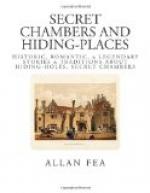Of all the ancient mansions in the United Kingdom, and there is still, happily, a large selection, none perhaps is so picturesque and quaintly original in its architecture as the secluded Warwickshire house Compton Winyates. The general impression of its vast complication of gable ends and twisted chimneys is that some enchanted palace has found its way out of one of the fairy-tale books of our early youth and concealed itself deep down in a sequestered hollow among the woods and hills. We say concealed itself, for indeed it is no easy matter to find it, for anything in the shape of a road seems rather to lead away from, than to it; indeed, there is no direct road from anywhere, and if we are fortunate enough to alight upon a footpath, that also in a very short time fades away into oblivion! So solitary also is the valley in which the mansion lies and so shut in with thick clustering trees, that one unacquainted with the locality might pass within fifty yards of it over and over again without observing a trace of it. When, however, we do discover the beautiful old structure, we are well repaid for what trouble we may have encountered. To locate the spot within a couple of miles, we may state that Brailes is its nearest village; the nearest town is Banbury, some nine miles away to the east.
Perhaps if we were to analyse the peculiar charm this venerable pile conveys, we should find that it is the wonderful colour, the harmonies of greys and greens and reds which pervade its countless chimney clusters and curious step-gables. We will be content, however, with the fascinating results, no matter how accomplished, without inquiring into the why and wherefore; and pondering over the possibilities of the marvellous in such a building see, if the interior can carry out such a supposition.
[Illustration: SCOTNEY HALL, SUSSEX]
[Illustration: COMPTON WINYATES, WARWICKSHIRE]
Wending our way to the top of the house, past countless old-world rooms and corridors, we soon discover evidences of the days of priest-hunting. A “Protestant” chapel is on the ground floor (with a grotesquely carved screen of great beauty), but up in the roof we discover another—a “Popish” chapel. From this there are numerous ways of escape, by staircases and passages leading in all directions, for even in the almost impenetrable seclusion of this house the profoundest secrecy was necessary for those who wished to celebrate the rites of the forbidden religion. Should the priest be surprised and not have time to descend one of the many staircases and effect his escape by the ready means in the lower part of the house, there are secret closets between the timber beams of the roof and the wainscot into which he could creep.
Curious rooms run along each side in the roof round the quadrangle, called “the barracks,” into which it would be possible to pack away a whole regiment of soldiers. Not far away are “the false floors,” a typical Amy Robsart death-trap!




